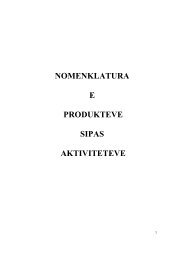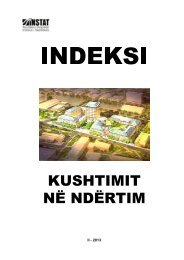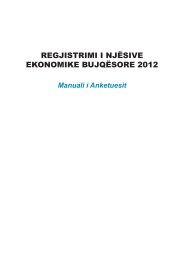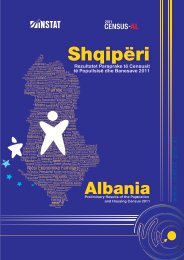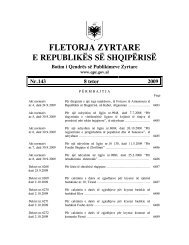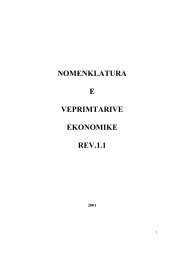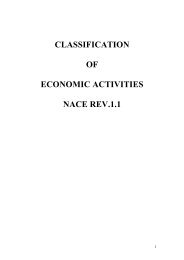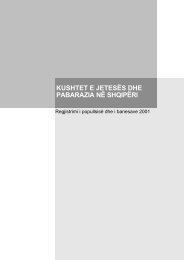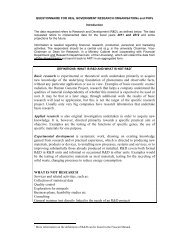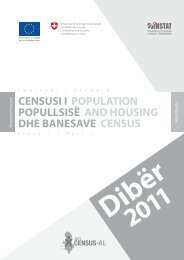Description of methods and sources for Albania - INSTAT
Description of methods and sources for Albania - INSTAT
Description of methods and sources for Albania - INSTAT
- No tags were found...
You also want an ePaper? Increase the reach of your titles
YUMPU automatically turns print PDFs into web optimized ePapers that Google loves.
IPA 2009 Multi-beneficiary StatisticalCooperation Programme3.1.6.3 Statistical surveyFor the estimation <strong>of</strong> the output <strong>of</strong> individual activities, basic statistical surveys areused. The most important ones are surveys <strong>of</strong> large enterprises (quarterly), the annualStructural Business Survey (SBS, annual) a Retail Trade Survey (quarterly), a Survey<strong>of</strong> Productive Enterprises (quarterly), the Survey <strong>of</strong> Construction Enterprises(quarterly) carried out by <strong>INSTAT</strong>. Other surveys cover the activities <strong>of</strong> agriculture,<strong>for</strong>estry <strong>and</strong> fishing carried out by the Ministry <strong>of</strong> Agriculture.For solving the problem <strong>of</strong> data <strong>sources</strong> on intermediate consumption a new surveywas designed in 2009 (annual data <strong>for</strong> 2008) to collect data in value terms <strong>for</strong> allinputs into individual activities. This data are not used till now.3.1.6.3.1 Annual Structural Business Survey (SBS)The main aim <strong>of</strong> structural business statistics is to show the structure <strong>of</strong> the businesssector with regard to economic data. Data <strong>for</strong> the total business sector, by branch <strong>and</strong>by size groups are present.The <strong>Albania</strong>n Structural Business Statistics are regulated by the Council Regulation(EC, EURATOM) No.58/97, 20 December 1996.The statistics comprise all active enterprises in <strong>Albania</strong>, <strong>of</strong> all legal <strong>for</strong>ms(agriculture, <strong>for</strong>estry, financial, public <strong>and</strong> private education, public <strong>and</strong> privatehealth, <strong>and</strong> cultural activities are not included).The population consists <strong>of</strong> all enterprises that, according to statistical register, wereactive in December <strong>of</strong> the reference year. Reporting units are companies, enterprises<strong>and</strong> other organizations. Periodicity is annual <strong>and</strong> the data refer to the calendar year.Preliminary results are available 11 months after the end <strong>of</strong> the reference year.The sample frame consists <strong>of</strong> all active enterprises in the Business Register (BR)classified into economic activities with at least 1 (one) employed, both the public <strong>and</strong>private sector is included: B (Fishing), C (Mining <strong>and</strong> quarrying), D(Manufacturing), E (Electricity, gas <strong>and</strong> water supply), F (Construction), I(Transport, storage <strong>and</strong> communication), G (Wholesale & retail trade; repair <strong>of</strong>motor vehicles, motor <strong>and</strong> personal <strong>and</strong> household goods), H (Hotels <strong>and</strong>restaurants), K (Real estate, renting <strong>and</strong> business activities), O (Other community,social <strong>and</strong> personal service activity) <strong>and</strong> P (Private households with employedpersons).The sampling frame is divided into strata based on economic activity, so calleddomain strata. Principally the two digit level is used to create these strata. Thestratification is done in order to fulfill the SBS regulation. The sample <strong>of</strong> the year2006 includes 9 467 units, enterprises with 1-4 employed are surveyed by samplesurvey (3 339 enterprises) <strong>and</strong> enterprises with 5 <strong>and</strong> more employed are surveyed33/236



